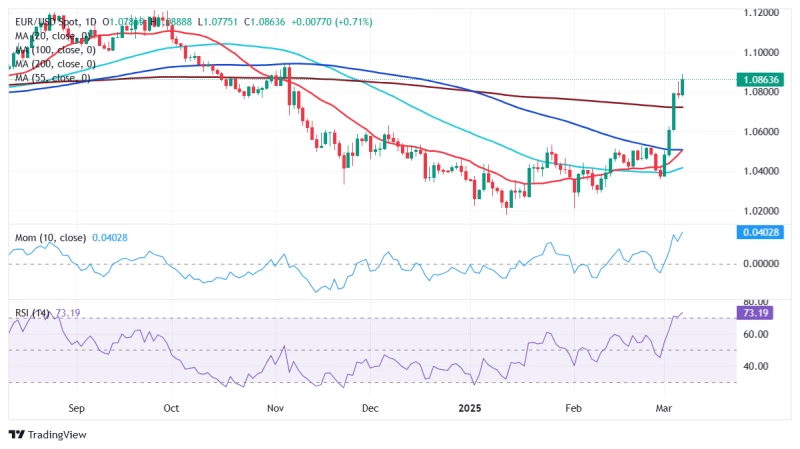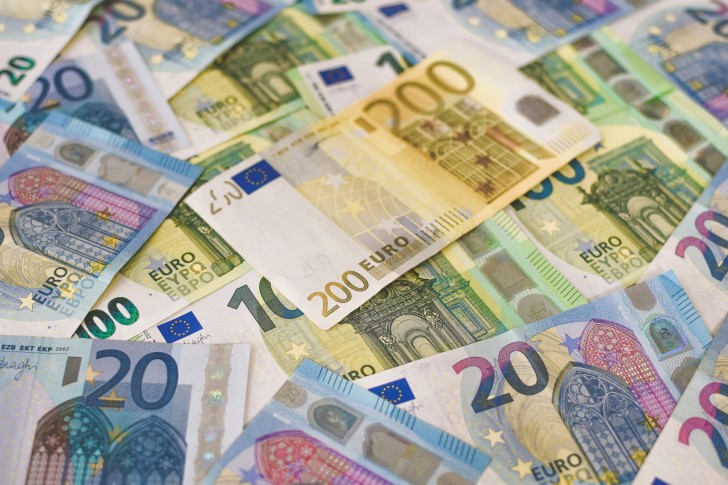The EUR/USD currency pair reached levels not seen since November, climbing to 1.0888 as the US Dollar faced significant pressure from trade war concerns and mixed economic data.
EUR/USD (EUR) Gains Momentum After ECB Rate Cut Decision
The European Central Bank (ECB) made its anticipated monetary policy announcement on Thursday, cutting all three key benchmark rates by 25 basis points. The deposit facility rate was reduced to 2.50%, the main refinancing operations rate to 2.65%, and the marginal lending facility rate to 2.90%. In the accompanying statement, officials noted that monetary policy is becoming "meaningfully less restrictive" while also highlighting increased uncertainties in the economic outlook.
During her press conference, ECB President Christine Lagarde maintained the bank's data-dependent approach, emphasizing that future decisions would continue to be made on a meeting-by-meeting basis. However, she also suggested the possibility of holding rates steady in upcoming meetings, which contributed to the Euro's upward momentum.
Lagarde additionally commented that the ECB's Governing Council believes the massive spending plans proposed by Germany and the European Commission would inevitably strengthen the EU economy, further bolstering confidence in the Euro.
German Leadership Proposes €500 Billion Fund Boosting EUR/USD (EUR)
The Euro received additional support from German headlines as Friedrich Merz, the incoming Chancellor and leader of the Christian Democratic Union (CDU), announced plans to increase military and infrastructure spending while pushing for similar actions across the European Union.
Merz, who must still form a government before March 25, has already secured an agreement with the Social Democratic Party (SPD) and Bavaria's Christian Social Union (CSU) to boost spending through a proposed €500 billion special fund. This fund aims to finance infrastructure projects outside normal budgetary constraints over the next decade.
This decisive move came as a response to US President Donald Trump's threat to withdraw support for Ukraine, which he ultimately enacted on Tuesday by freezing aid to the war-torn country.
In parallel developments, European Commission President Ursula Von der Leyen presented an ambitious plan to mobilize approximately €800 billion for Europe's defense infrastructure and provide immediate military support for Ukraine following Washington's aid suspension. The EU plans to issue bonds and loosen regulations to free up this substantial amount.
Disappointing US Employment Data Further Weakens Dollar Against EUR/USD (EUR)
Throughout the week, economic data releases focused primarily on growth indicators and US employment figures, although their market impact was somewhat diminished by trade war headlines.
The February Nonfarm Payrolls (NFP) report revealed that the US economy added 151,000 new jobs, falling short of the expected 160,000. The unemployment rate edged higher to 4.1% from January's 4.0%, while the labor force participation rate declined to 62.4% from the previous 62.6%. Average hourly earnings increased to 4.0% from a revised 3.9% (originally reported as 4.1%).
Other employment indicators painted an even more concerning picture. The ADP report showed private sector job additions of just 77,000 in February, significantly below the anticipated 140,000. According to the Challenger Job Cuts report, US-based employers announced plans to eliminate 172,017 positions in February—a 103% increase from January and the highest February total since 2009.
Meanwhile, fourth-quarter unit labor costs declined to 2.2% from the previous quarter's 3.0%, although nonfarm productivity improved to 1.5% from Q3's 1.2%.
Manufacturing and services data showed mixed results. The US ISM Manufacturing PMI contracted to 50.3 in February from January's 50.9, while the ISM Services Index improved from 52.8 to 53.4. The final S&P Global US Services PMI for February came in at 51.0, better than the 49.7 anticipated.
EUR/USD (EUR) Technical Analysis Shows Strong Bullish Momentum
The EUR/USD pair gained approximately 460 pips over the past five trading days, marking its best weekly performance in decades. Technical indicators from the weekly chart support continued upward movement, particularly if the pair surpasses the recent high of 1.0888, where a bearish 200 Simple Moving Average (SMA) provided resistance. The pair has rallied past the still flat 20 and 100 SMAs, with the shorter one losing its downward momentum. Technical indicators have crossed their midlines into positive territory, maintaining almost vertical trajectories that suggest higher levels ahead.
The daily chart shows EUR/USD in extremely overbought territory, yet technical indicators continue to point north, suggesting the rally may continue before a significant corrective decline occurs. The pair has moved beyond all its moving averages, with the 20 SMA turning upward below the longer ones. The 200 SMA now provides dynamic support around 1.0725.
Immediate support sits at the 1.0800 threshold, followed by the aforementioned 200-day SMA and December's peak at 1.0629. A move beyond 1.0890 would expose the psychological 1.1000 mark, ahead of the 1.1080 region. Further gains could open the door for a test of the September 2024 high at 1.1213.

 Saad Ullah
Saad Ullah

 Saad Ullah
Saad Ullah


